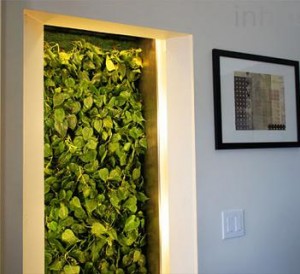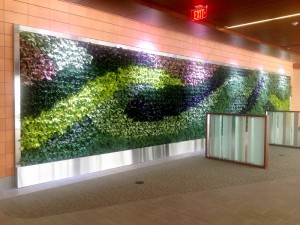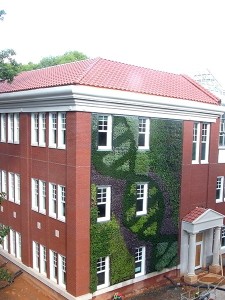Late last month I came across Adrianne Jeffries’s piece on The Verge “Nearly half of Americans live with dangerous levels of air pollution…” (hint: the title kind of gives it all away). Given all the dramatic coverage of pollution in China and, to a lesser extent, India, I thought the article was surprising. While the worst cities in America are likely to be much less worse off than Beijing or India, I had always assumed that we had a pretty good handle on pollution since what I remember as being a big anti-pollution push in the 1970s. All of this in mind, Ben Schiller’s piece on Purdue University’s Biowall caught my eye and sparked my imagination.
First, the Biowall from the folks at Purdue University:
(Image from Purdue University’s Biowall page)
As Schiller points out, the Biowall is based on longstanding research by a NASA scientist. That said, the folks at Purdue University cite some interesting facts and research:
The average American spends more than 90% of his or her time indoors where the air is 2-5 times more polluted than outdoors…Taken as a whole, poor indoor air quality (IAQ) is estimated to cost the United States at least $40 billion annually due to related illness and lost productivity (Fisk, 2000).
While this passage begs some questions (“Two to five times more polluted than what? Local air quality? The national average?”), I think we all can agree that, even without context, that it is not good.
I think we also can agree that green walls can look very cool, whether they are inside…
(Image from GSky Plant Systems awesome DAHLC Mayo Clinic project)
…or outside
(Another beauty from GSky Plant Systems, this time a project for Queens University of Charlotte)
For more green wall porn, I also suggest you take a look at the Greenwalls Vertical Planting Systems Web site.
So, back to the Biowall.
I walked out of the article with three questions:
- Are green walls (or appliances or interface to an HVAC system like the Biowall is) going to be viable if I do not have a green thumb? I say this as a guy who has killed more houseplants and potted plants than I care to admit.
- Are there pet-friendly plants that make for effective green walls (or appliances or HVAC interfaces)? On the one hand, I would rather not find Fido poisoned. On the other, I would rather not deal with a wide-eyed cat hepped up on a plant with catnip-like qualities. There has got to be a solution in between, right?
- Could I integrate food production into my green wall (or appliance or HVAC interface)? I have previously written about aquaponics. Would an aquaponic system attached to (or integrated in) a house serve a similar function? Alternatively, could a Biowall support the growing of food?
Two other articles crossed my radar screen that had me thinking about green walls in a broader sense:
First, another article by Ben Schiller: “Honda Is Designing Houses, Because Cars And Homes Will All Be Part Of The Smart Grid.” This one caught my eye because Honda is more systemically than I thought previously (I tend to think of them in terms of their work with robotics). As I wrote about previously, Palo Alto is getting there, in a narrowly defined scope. Who else is trying to get there strategically?
The second was an article by Nobel laureate Joseph Stiglitz: “A Light Unto Cities,” which looked at the critical role plays in creating livable cities. The thought that resonated with me, however, was when he talked about how participants at the conference he was reporting on did not think that a “livable city” was enough. Rather:
We need to create urban areas in which individuals can flourish and innovate. It is no accident that the Enlightenment – which led in turn to the fastest and largest increases in living standards in human history – unfolded in cities. New thinking is a natural consequence of high population density, provided the right conditions are met – conditions that include public spaces in which people can interact and culture can thrive, and a democratic ethos that welcomes and encourages public participation.
I hope green walls play a role in these public, and even our private, spaces.



